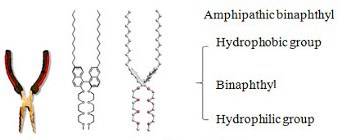
Current nanotechnology is about nanomaterials, nanodevices, and simple molecular machines. Advanced nanotechnology will largely be about complex systems of artificial molecular machines, rather as life can be described as complex systems of biological molecular machines. So any new insight about molecular machines is of potential interest as a signpost toward advanced nanotechnology. A hat tip to AZO NANO for reprinting this press release from Japan’s National Institute for Materials Science “Motion of Supramolecular Machines Successfully Controlled through Simple Mechanical Manipulation“:
NIMS MANA researchers found that molecular machines can be easily manipulated using very small mechanical energy, taking advantage of the property that they aggregate on the surface of water. This study was published in the online version of the German Chemical Society’s journal “Angewandte Chemie International Edition” on June 12, 2015. (D. Ishikawa, T. Mori, Y. Yonamine, W. Nakanishi, D. L. Cheung, J. P. Hill, and K. Ariga “Mechanochemical tuning of binaphthyl conformation at the air-water interface” Angew. Chem. Int. Ed., DOI: 10.1002/anie.201503363)
MANA Scientist Waka Nakanishi and other researchers at the Supermolecules Unit (Katsuhiko Ariga, director) of the NIMS International Center for Materials Nanoarchitectonics (MANA), in collaboration with Dr. David Cheung at the University of Strathclyde (UK), found that molecular machines (molecules capable of mechanical movement) can be easily manipulated using very small mechanical energy, taking advantage of the property that they aggregate on the surface of water. Our findings are expected to contribute to the development of basic technology for the operation of various molecular machines that have been studied for their application as sensor and other types of devices.
The way mechanical energy works to run a machine has been well understood and put into application at a macro level. In contrast, due to limited quantitative methods available, it had been poorly understood at the nano level, as illustrated by molecular machines, how the whole mechanical force spreads and impacts the molecular conformation and function. In order to apply mechanical energy at the molecular level and to freely manipulate molecular-level machines, it is critical to understand operating principles that explain these questions.
We recently succeeded in taking detailed measurements on conformational change in molecules in relation to pressure exerted on them as we applied mechanical energy to molecular machines (supramolecular assembly) that aggregated at the air–water interface. In this study, we used plier-shaped binaphthyl molecules as molecular machines. At the air–water interface, binaphthyl molecules are arranged in the same orientation and aligned, forming a single-molecule-thick film. When we applied external mechanical energy to compress and expand this film by moving a partition on the surface of water, we were able to efficiently and repeatedly open and close the binaphthyl molecules. Thus, we concluded that the angle at which the molecules open and close can be controlled by applying a very small force.
To date, conformational change in molecular machines had been measured three-dimensionally. At the two-dimensional air–water interface, molecular arrangements are simpler. In addition, while a supramolecular assembly is very small with a thickness at only a molecular level, its area is large enough to be visible to the naked eye. As such, change in molecular conformation can be observed by precisely controlling the movement of the partition, which can be shifted manually, using machines. In this way, it is now feasible with comparative ease to understand these phenomena in detail. Moreover, based on the fact that the level of mechanical energy we applied in this study was much smaller than the levels of optical and thermal energies normally used to run molecular machines, there are high expectations on this technology for its potential to develop into a simple and energy-saving new nanotechnology. …
In the summary at the end of their paper, the authors state “We anticipate that the use of the air–water interface as a medium for mechanochemistry will open a new field involving molecular conformational control and consequent control of molecular function.” It is difficult for me to imagine how a collection of molecular machines floating on an air-liquid interface could be controlled to do useful complex work, but perhaps machines on a solid surface? It should be interesting to follow how these researchers apply their novel observation.
—James Lewis, PhD
